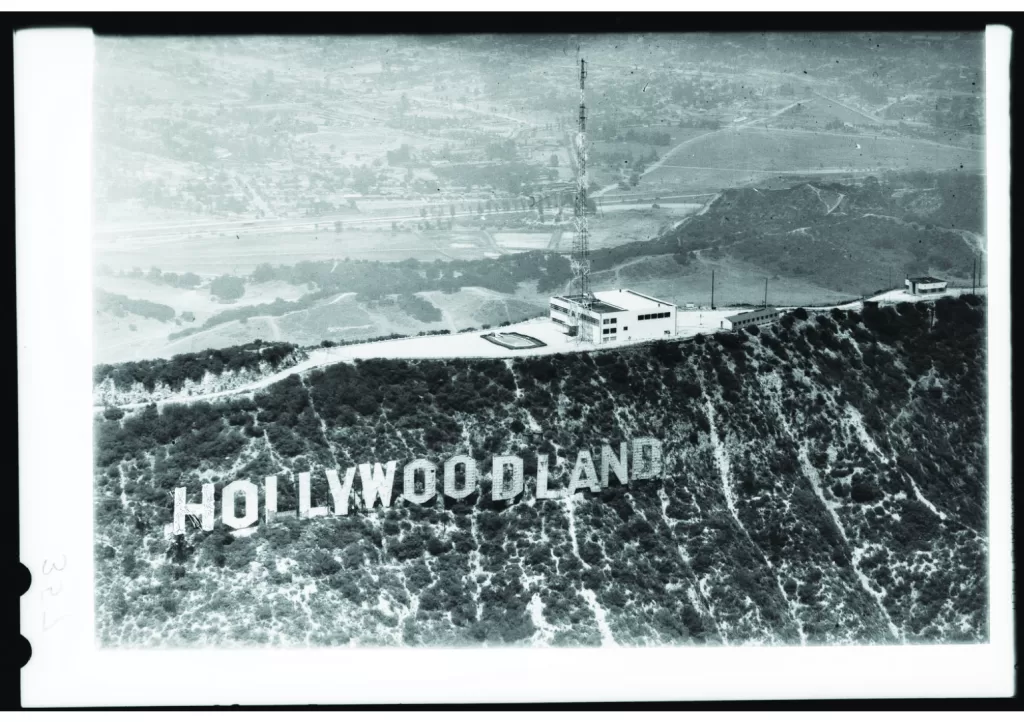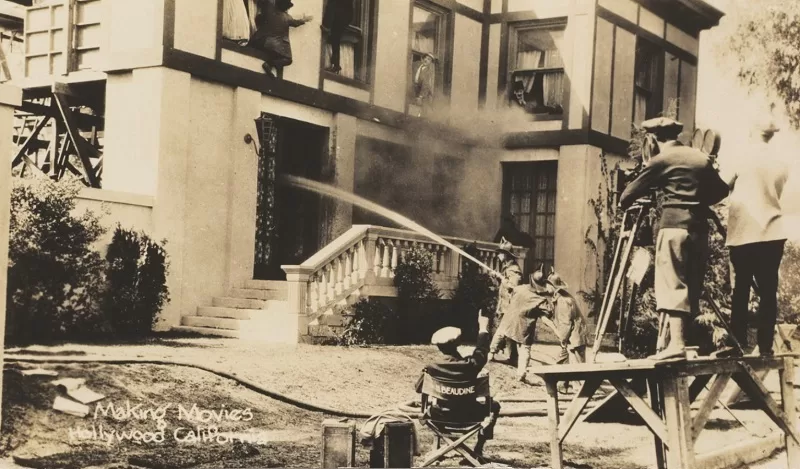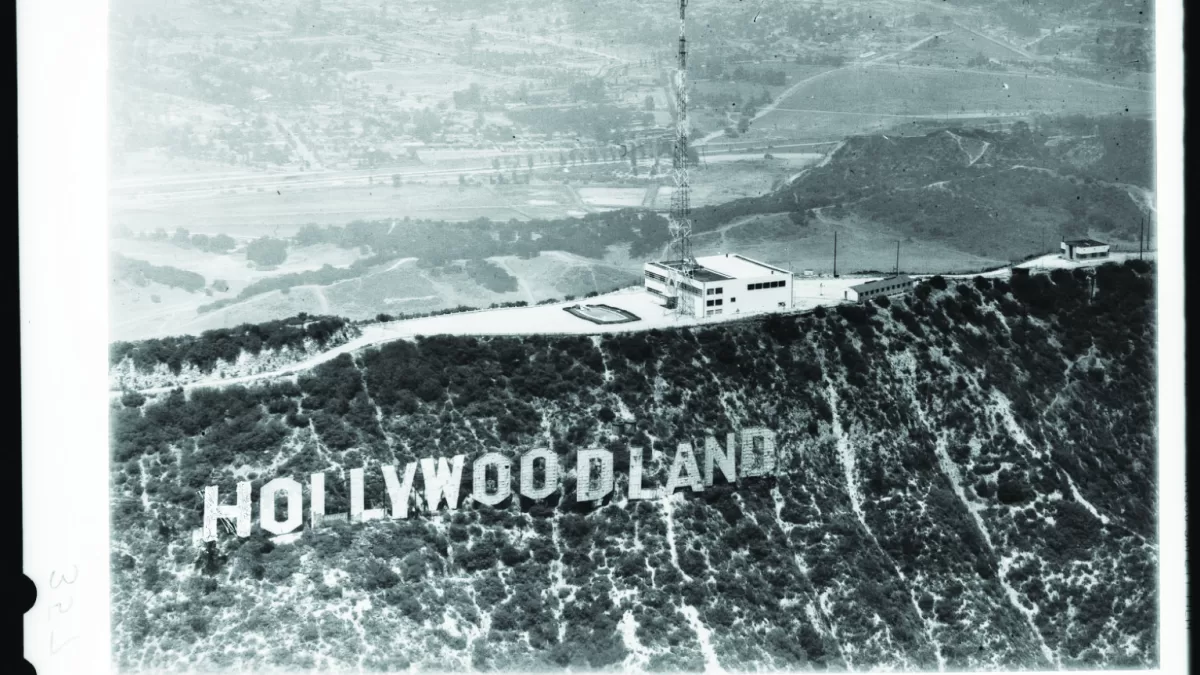In part one of the latest column from @LostCanyonsLA writer Emmeline Summerton, we’re exploring the connection between the golden age of Hollywood and the Los Angeles canyons – both on and off the screen.

With the Hollywood awards season about to ramp up through January, there’s no better time to explore the role the LA canyons have played in shaping Hollywood history. From the very first filmmakers who made their way to Los Angeles in the early part of the 20th century, the canyons, and their unique homes, have provided the perfect backdrop for movie locations and the exciting private lives of movie stars ever since.
Early filmmakers, then primarily located in New York and New Jersey, began to hear LA’s siren call in the early 1900s when the Los Angeles Chamber of Commerce first boasted of the city’s “350 days of sun” in a brochure aimed at those brave enough to venture west.

In the book Location Filming in Los Angeles, film historians Karie Bible, Marc Wanamaker, and Harry Medved state that early filmmakers found, “the city to be an ideal place to make movies with a host of attributes: inexpensive land, a mild year-round climate, and a diverse geography.”
A 1924 article published in Cinema Review magazine extolled the virtues of Los Angeles, claiming that any kind of location could be found within the city, including “rugged mountains and pastoral valleys, country lanes and city streets, jungles and deserts, every kind of a building from castles and mansions to hovels and dog houses. All as near as possible to the studio.”
Over the next 100 years, the LA canyons would go on to double for the Wild West, Shanghai, Morocco, ancient Rome, and even outer space.
The first movie to be filmed in the canyons and hills of LA is thought to be D.W. Griffith’s In Old California, a historical drama shot on location in the eastern end of the Hollywood Hills and Cahuenga Pass in 1910. Griffith, most famous for his controversial film Birth of a Nation, was the principal director of The Biograph Company and among the first of the east coast directors to divide filming between New York in the warmer months and Los Angeles in the winter.
Not far from that first film location is the canyon that would become most synonymous with movies of the Western genre. Originally a rock quarry, Bronson Canyon has been a filming location since 1912. Its dusty, rocky terrain and caves (eventually immortalized as the Bat Cave in TV’s Batman) made it the perfect spot for wild action scenes in movies like 1956’s The Searchers and Ride the High Country in 1962. Other notable non-western movies filmed in the canyon include 1951’s Ten Tall Men, starring Burt Lancaster as Julius Caesar with Marlon Brando in 1953. Today, it is part of Griffith Park.
Other nearby canyons in the Hollywood Hills, including Beachwood Canyon, Whitley Heights and the Hollywood Dell, became desirable homes for early movie stars. Hollywood’s two famous “Latin Lover” archetypes, Ramon Novarro and Rudolf Valentino both lived in the area; Novarro in a gorgeous 1928 Mayan Revival home designed by Lloyd Wright (son of Frank) on Canyon Drive, and Valentino in a 1922 Italianate Villa in Whitley Heights. Cary Grant and Randolph Scott also shared a house here in the early 1930s, before Grant’s wife Virginia Cherril moved in and Scott moved out.
Beachwood Canyon’s own major movie claim to fame is the incredible chase scene in the 1956 cult classic Invasion of the Body Snatchers that sees its heroes pursued through the canyon’s little village and over the hill to the Bronson Caves by alien “Pod People.” The same Beachwood Canyon intersection seen in Invasion of the Body Snatchers appeared in another alien body-snatching film that same year, Roger Corman’s It Conquered the World.
Non-body snatching residents of Beachwood Canyon included Charlie Chaplin, Bela Lugosi, and Humphrey Bogart—before he married Lauren Bacall and moved to Benedict Canyon.
Heading west across the Hollywood Hills we reach Nichols Canyon, once home to early Hollywood luminaries such as Joan Crawford, Ava Gardner and Errol Flynn (whose notorious party house had a casino, secret passageways, two-way mirrors and peepholes) and later Steve McQueen who, according to his wife Neile Adams’s autobiography, got into heated arguments with neighbors over the noise his Jaguar XK-SS prototype made on its daily drive through the canyon.
Next up is Laurel Canyon where Katherine Hepburn played a gender-bending woman in 1935’s Sylvia Scarlett, Charlie Chaplin parodied Hitler in 1940’s The Great Dictator and where Jerry Lewis dodged an ambulance on Lookout Mountain Drive in 1964’s The Disorderly Orderly. Of course, Laurel Canyon is now best known for its musicians of the 1960s and 1970s but in Hollywood’s early heyday it was home to original cowboy actor Tom Mix (who lived in a former 1915 tavern turned log cabin home that was eventually taken over by Frank Zappa in 1967), 1950’s hipsters including Marlon Brando, James Dean, Natalie Wood and Dennis Hopper. Robert Mitchum also had a home in the canyon and was famously arrested for marijuana possession in the nearby home of actress Lila Leeds in 1948, before he later moved to Mandeville Canyon.
Rising above Beverly Hills, it’s no wonder that Franklin, Benedict, and Coldwater canyons were both home and workplace for many of Hollywood’s early elites. Franklin Canyon and its secluded lake has been featured in many films such as 1938’s Four Men and a Prayer, where it stood in for a lake in Oxford, England and where John Ford directed a rowing crew that was actually from UCLA. The canyon’s lake also appears in 1954’s Creature from the Black Lagoon and 1962’s The Manchurian Candidate.
In 1918, Mary Pickford and Douglas Fairbanks ruled over Hollywood from their mansion “Pickfair” off Benedict Canyon Boulevard. Together with their nextdoor neighbor Charlie Chaplin, and D. W. Griffith, the couple created United Artists in 1919, a film distribution company that gave actors more control over their own work.
Another early studio magnate to settle in the canyon was Thomas Ince, known as the “Father of the Western” who built his home, “Dias Dorados,” in 1922. Ince would later die at home of heart failure, but his death has long been speculated over, with many believing he was shot by William Randolph Hearst on board his yacht. Ince’s home was sold to another studio executive, Carl Laemmle, founder of Universal Pictures.
Elizabeth Taylor and her close friend Montgomery Clift were neighbors in Benedict Canyon and shared a scary night in 1956 when he was seriously injured in a car accident leaving her home on the treacherously twisting Benedict Canyon Boulevard.
Bette Davis and her first husband Harman “Ham” Nelson lived in neighboring Coldwater in the late 1930s, as did Charlton Heston. Around the same time, Paramount musical comedy Every Night at Eight (that featured the hit song “I’m in the Mood for Love”) was filmed in the canyon. Near the end of his life, publishing magnate William Randolph Hearst and his actress sweetheart Marion Davies also shared a home in Coldwater that was later used in a scene for The Godfather in 1971. From Claudette Colbert’s famous hitchhiking scene in 1934’s It Happened One Night in Franklin Canyon, to the 1936 film version of Flash Gordon, with the titular character taking his first steps onto the planet Mongo in Bronson Canyon, the LA hills and canyons have provided filmmakers and actors with not just the ideal location for their movie-making magic but also the perfect playground for their glamorous, sometimes complicated and tragic lives.













